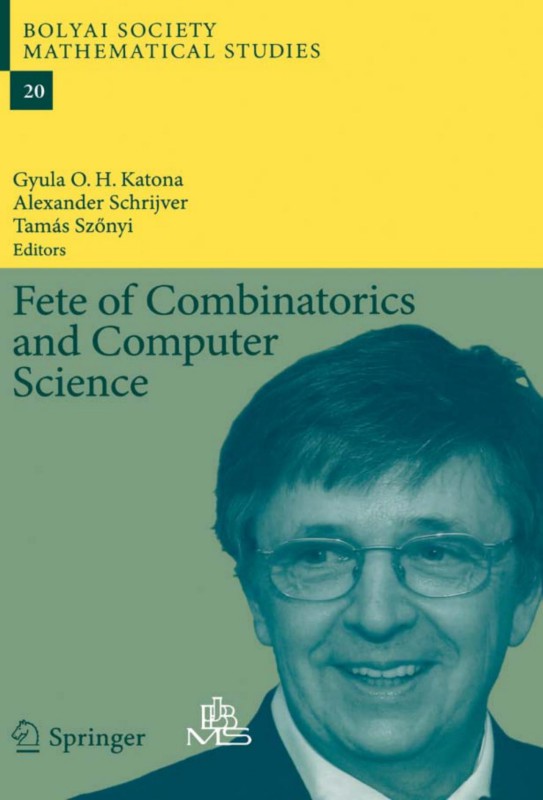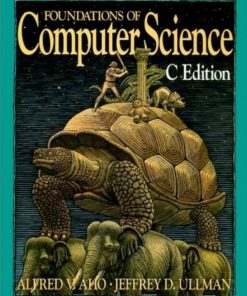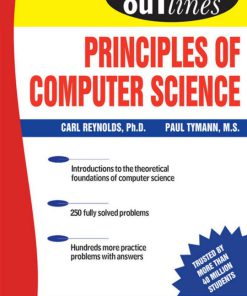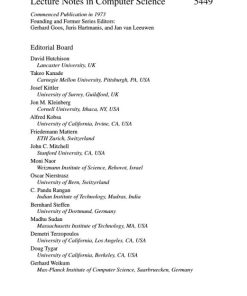Fete of Combinatorics and Computer Science 1st Edition by Gyula OH Katona, Alexander Schrijver, Tamas Szonyi ISBN 3642135803 9783642135804
$50.00 Original price was: $50.00.$25.00Current price is: $25.00.
Authors:Gyula O.H. Katona, Alexander Schrijver, Tamás Szönyi , Tags:Springer 2010 , Author sort:Gyula O.H. Katona, Alexander Schrijver, Tamás Szönyi , Ids:364213579X , Languages:Languages:eng , Published:Published:Feb 2011 , Comments:Comments:Springer 2010
Fete of Combinatorics and Computer Science 1st Edition by Gyula OH Katona, Alexander Schrijver, Tamas Szonyi – Ebook PDF Instant Download/Delivery. 3642135803, 9783642135804
Full download Fete of Combinatorics and Computer Science 1st Edition after payment
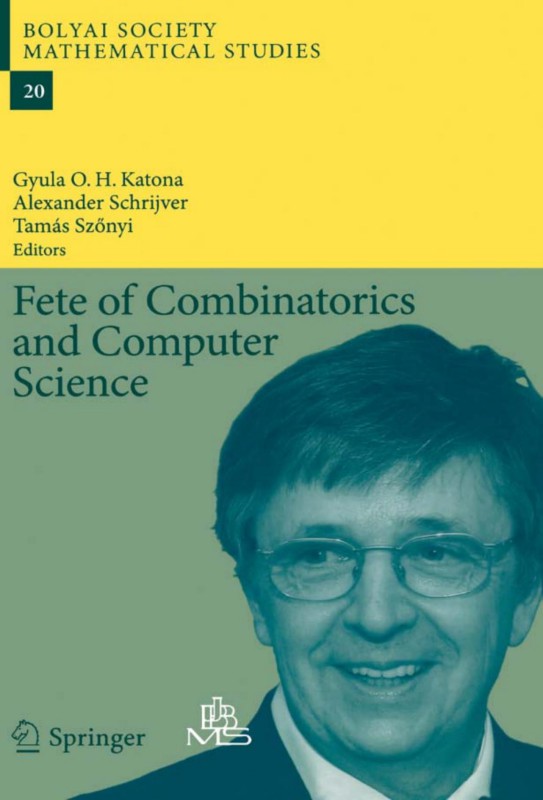
Product details:
ISBN 10: 3642135803
ISBN 13: 9783642135804
Author: Gyula OH Katona, Alexander Schrijver, Tamas Szonyi
Discrete Mathematics and theoretical computer science are closely linked research areas with strong impacts on applications and various other scientific disciplines. Both fields deeply cross fertilize each other. One of the persons who particularly contributed to building bridges between these and many other areas is László Lovász, whose outstanding scientific work has defined and shaped many research directions in the past 40 years. A number of friends and colleagues, all top authorities in their fields of expertise gathered at the two conferences in August 2008 in Hungary, celebrating Lovász’ 60th birthday. It was a real fete of combinatorics and computer science. Some of these plenary speakers submitted their research or survey papers prior to the conferences. These are included in the volume “Building Bridges”. The other speakers were able to finish their contribution only later, these are collected in the present volume.
Fete of Combinatorics and Computer Science 1st Table of contents:
1. INTRODUCTION
2. REGULAR GRAPHS
3. THE PROOF OF THE MAIN RESULT
4. CONCLUDING REMARKS AND OPEN PROBLEMS
REFERENCES
ITERATED TRIANGLE PARTITIONS
1. INTRODUCTION
2. SUBDIVIDING BY BISECTORS
2.1. Subdividing into three daughters
2.2. Dividing into six triangles
2.2.1. The smallest angle.
3. SUBDIVIDING BY MEDIANS
3.1. Analytic approach
3.2. Hyperbolic approach
4. SUBDIVIDING BY THE GERGONNE POINT
5. SUBDIVIDING BY THE LEMOINE POINT
6. CONCLUDING REMARKS
REFERENCES
PAGERANK AND RANDOM WALKS ON GRAPHS
1. INTRODUCTION
2. LAPLACIAN, THE GREEN’S FUNCTION AND PAGERANK
3. PAGERANK, THE HITTING TIME AND THE EFFECTIVE RESISTANCE IN ELECTRICAL NETWORKS
4. SEVERAL MATRIX-FOREST THEOREMS
5. PAGERANK AND OTHER INVARIANTS IN TERMS OF ROOTED SPANNING FORESTS
6. USING THE GENERALIZED HITTING TIME TO FIND SPARSE CUTS
7. USING PAGERANK TO ESTIMATE THE EFFECTIVE RESISTANCE
REFERENCES
SOLUTION OF PETER WINKLER’S PIZZA PROBLEM*!
1. INTRODUCTION
2. THE LOWER BOUND
2.1. Preliminaries
2.2. Minimal triples
2.3. An auxiliary one-jump strategy
2.4. A two-jump strategy
2.4.2. Alice’s strategy in the first phase.
2.4.3. Alice’s strategy in the second phase.
2.4.4. Analysis of Alice’s gain.
2.5. Proof of the lower bound
3. THE UPPER BOUND
4. FIXED NUMBER OF SLICES
5. CUTTINGS INTO 15 AND 21 SLICES
6. ONE-JUMP STRATEGIES
6.1. Lower bound
6.2. Upper bound
7. ALGORITHMS
7.1. Linear Algorithm
7.2. Optimal strategies
REFERENCES
TIGHT BOUNDS FOR EMBEDDING BOUNDED DEGREE TREES
1. INTRODUCTION
2. THE NON-EXTREMAL CASE
2.1. Some tools for the proofs in the non-extremal cases
2.2 . The first non-extremal case: T has a broad subtree
2.2.1. Preparations
2.2.2. Decomposition of
2.2.3. Sketch of the embedding algorithm.
2.2.4. Finishing the embedding of T.
2.2.5. The Main Mapping Procedure.
2.2.6. The Second Mapping Procedure.
2.2.7. The Third Mapping Procedure.
2.2.8. Description of the Embedding Algorithm.
2.3. The second non-extremal case: T has a long subtree
2.3.1. Preparations for the embedding
2.3.2. Embedding T into G.
2.3.3. Finishing the embedding.
3. THE EXTREMAL CASE
3.1. The First Extremal Case
3.2. The Second Extremal Case
4. LOWER BOUND FOR THE MINIMUM DEGREE IN G
4.1. The First Extremal Case
4.2. The Second Extremal Case
REFERENCES
BETTI NUMBERS ARE TESTABLE*
1. INTRODUCTION
2. THE CONVERGENCE OF SIMPLICIAL COMPLEXES
3. BETTI NUMBERS AND COMBINATORIAL LAPLACIANS
4. WEAK CONVERGENCE OF PROBABILITY MEASURES
5. SPECTRAL CONVERGENCE
6. THE PROOF OF THEOREM 1
REFERENCES
RIGID AND GLOBALLY RIGID GRAPHS WITH PINNED VERTICES
1. INTRODUCTION
2. RIGID FRAMEWORKS WITH PINNED VERTICES
3. RIGID GRAPHS WITH PINNED VERTICES
4. THE TWO-DIMENSIONAL RIGIDITY MATROID
5. OPTIMAL FAMILIES OF TRACKS AND SMALLEST PINNING SETS
6. THE NETWORK LOCALIZATION PROBLEM
7. GRAPHS WITH A CONNECTED RIGIDITY MATROID
7.1. M-connected graphs with pinned vertices
8. LOW COST ANCHOR SETS IN UNIQUELY LOCALIZABLE NETWORKS
REFERENCES
NOISE SENSITIVITY AND CHAOS IN SOCIAL CHOICE THEORY
1. INTRODUCTION
2. PROOFS OF THE EQUIVALENCE THEOREMS
2.1. A coupling argument
2.2. An elementary harmonic analysis argument
2.3. Individual power
3. MULTI-LEVEL MAJORITY
3.1. Simple majority
3.2. Multi-level games based on simple majority
3.3. Two-level games based on supermajority
4. BIAS
5. DEPENDENCE
6. ABSTENTION
7. DISCUSSION
1. The superiority of majority.
2. Aggregation of information.
3. Indeterminacy.
4. Noise stability.
5. Other economic models.
6. The asymptotic nature of our results.
8. CONCLUSION
9. APPENDIX
9.1. Proofs of properties of simple majority
9.2. Proof of Theorem 4.3
9.3. It ain’t over until it’s over
REFERENCES
COLORING UNIFORM HYPERGRAPHS WITH SMALL EDGE DEGREES
1. INTRODUCTION
2. COLORING PROCEDURE EVOLUTION AND ITS PROPERTIES
3. STRUCTURE OF CAUSE TREES
4. AUXILIARY EVENTS
5. PROBABILITIES OF THE AUXILIARY EVENTS
6. PROOF OF THEOREM 2
REFERENCES
EXTREMAL GRAPHS AND MULTIGRAPHS WITH TWO WEIGHTED COLOURS
1. INTRODUCTION
2. BACKGROUND
2.1. The probability of hereditary properties
2.2. Edit distance
2.3. Directed graphs and multigraphs
2.4. Graph sequences
3. GENERAL RESULTS
3.1. Continuity and convexity
3.2. Basic facts
3.3. Core types
3.4. Exactness
3.5. Stability and Finiteness
3.6. Incomplete extremal graphs
4. GRAPH GAMES AND INCOMPLETE EXTREMAL GRAPHS
5. EXAMPLES
5.1. Simple examples
5.2. Less simple examples
5.3. Complete bipartite examples
5.4. K3,3
REFERENCES
REGULARITY LEMMAS FOR GRAPHS
1. INTRODUCTION
2. REGULARITY LEMMAS
2.1. The regularity lemma of Frieze and Kannan
2.2. Szemeredi’s regularity lemma
2.3. The (e,r)-regularity lemma
2.4. The regularity lemma of Alon, Fischer, Krivelevich, and M. Szegedy
2.5. The regular approximation lemma
2.6. An early version of the regularity lemma
3. REDUCED GRAPH AND COUNTING LEMMAS
3.1. The global counting lemma
3.2. The local counting lemma
3.3. The removal lemma and its generalizations
4. GRAPH LIMITS
REFERENCES
EDGE COLORING MODELS AS SINGULAR VERTEX COLORING MODELS
1. INTRODUCTION
2. FINITE RANK FUNCTIONS ON POLYNOMIAL RINGS
3. EDGE COLORING MODELS OF FINITE RANK
4. SINGULAR VERTEX COLORING MODELS
5. HYBRID MODELS AND DIRECTED EDGE MODELS
6. EXAMPLES AND REMARKS
REFERENCES
LIST TOTAL WEIGHTING OF GRAPHS
1. INTRODUCTION
2. THE MAX-MIN WEIGHTING METHOD
3. APPLICATION OF THE MAX-MIN METHOD
4. ALGEBRAIC METHOD
REFERENCES
OPEN PROBLEMS
1. THE GROTHENDIECK CONSTANT AND THE LOVASZ THETA FUNCTION (AN OPEN PROBLEM)
2. QUADRUPARTIONS
3. CHROMATIC NUMBER OF A RANDOM SUBGRAPH
4. TWO CONJECTURES ON QUASI-KERNELS
5. PARTITIONING GRAPHS INTO LARGE STARS
6. OPEN PROBLEMS ON GIRTH
7. CHROMATIC NUMBER OF SUBGRAPH
8. EDMONDS GRAPHS
9. COUNTING CONVEX COLORINGS OF GRAPHS
10. MAXIMUM NUMBER OF K r,r SUBGRAPHS
11. ON HAJNAL’S TRIANGLE-FREE GAME
12. IS TWO COLORING ALWAYS POLYNOMIAL?
13. PIZZA PROBLEM
People also search for Fete of Combinatorics and Computer Science 1st:
fete of combinatorics and computer science
combinatorics and computer science
combinatorics conferences
combinatorics computer science
combinatorics frq

